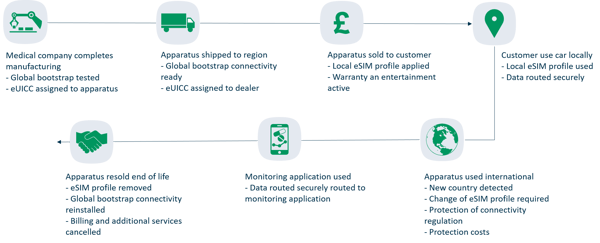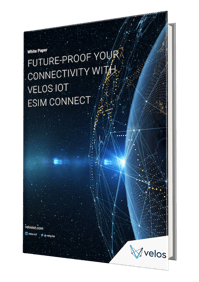

SIM profile management – linear or circular?
Traditional SIM profile management follows a linear production model – from the manufacturing of the card with a specific MNO profile, until its end of life.

Characteristic for the linear model - the personalisation of the SIM - is done during the pre-issuance. Once activated, the SIM will run on the pre-defined settings until the end of its life. The only possible way to make changes to the SIM settings after activation is to change the SIM itself.
Linear SIM profile management is most suitable for customers that are fine with being locked into an MNO, depending on its roaming footprint. This fits for example immobile IoT-enabled devices or mobile devices with a fixed pre-defined work area, with little deviation. In simple words, it is suitable for predictable device lifecycles. However, you need to be aware that an MNOs roaming footprint can change.
Demand has called for the development of a digital management option for connectivity, also known as an eSIM solution that offers a much more flexible post-issuance profile management. Most notable applications are within the automotive and consumer electronics sector, where devices are constantly on the move and need a wider array of IoT connectivity access options.
In the case of M2M projects, there are several reasons why a business would look to change the MNO profile on their IoT SIMs during the pre-issuance, such as:
-
Simplified production with one SKU/SIM Card
eSIM is a global standard, and standardised production can realise a high return of investment, cost optimisation and fewer production errors. Every IoT device can contain both the same module and SIM card. eSIM is the solution that supports multiple profiles and circular profile management, which can be used on all types of eUICCs independent of robustness classes and form factors. It can even be used in an integrated SIM on application processes.
-
Network access
Many IoT projects need global connectivity access. But what happens if your initial MNO provider loses roaming access or changed its roaming footprint in a country you need, with no plan B option for you? If you choose or are forced to change your provider, this could result in worse mobile coverage in the country your IoT application is deployed in, changes in access to technology due to the sunset of i.e. 2G/3G, changes in the roaming footprint, and in the worst-case scenario - additional charge for physically changing your SIMs. However, with an eSIM solution, you would be able to swap from your original profile to one that has access to the market you need.
-
Pricing
Roaming prices change on a regular basis and it depends solely on the connectivity provider’s network agreement on how much it would cost your business to connect devices A and B in your market of choice. Sometimes your initial provider cannot offer you the pricing you are willing or able to pay and you may be forced to change your MNO profile. With an eSIM solution, you can swap to a profile with more suitable pricing. Most importantly the power is transferred from the MNO to you since you can decide to change if you are not satisfied with the prices.
-
Market access and local regulations
Some of the biggest markets – the USA, Canada, and Brazil – have special IoT roaming restrictions in place due to local MNO rules and/or local regulator laws. Such laws make deployment in the markets challenging at best, and impossible at worst. An eSIM solution would allow you to access any of these markets through a local provider and legally deploy with a local profile, compared to a roaming solution, but keep your original MNO as a fallback in case of emergency.
-
Connectivity resilience
Network failures happen even to the best providers, but critical IoT projects such as connected medical devices, cannot afford to wait for connectivity to be restored. Sometimes having several MNO profiles on your IoT SIMs can ensure that in case one fails, there is always a plan B to swap to.
-
Faster global scaling
When you expand quickly to a new market and technology (CAT-M1/NB-IoT) you need to know that your solution can scale fast and easy, without the need to negotiate with your roaming partner or in the worst case - replace the physical SIM to migrate to a new MNO. With eSIM you sit on the power to decide your future and who you want to work with.
To answer these demands, the eSIM technology was developed to allow SIM cards to work with a digital post-activation subscription cycle, as follows:

In such cases, the SIM profile can be changed post-issuance and managed by the business as needed. For example, this is useful for re-selling IoT-enabled devices, where one profile may be needed for testing and another for usage. Circular SIM management gives more flexibility when it comes to how the devices are handled and how suitable they are for a wide variety of cases, especially when the lifecycle of the device has variables.

If we take for example the lifecycle of an IoT-enabled medical device, we can see the benefits of circular digital SIM lifecycle management. Some examples of smart healthcare devices that rely on the internet of things include personalised health monitoring devices like smart wearables, biosensors, mood monitors, smart pillboxes, automated insulin systems, smart inhalers, ingestible sensors and more. A large number of all smart medical devices are carried on person, hence the need to transmit data from wherever the person is located could be a matter of life and death.
In the production phase, the device manufacturer would embed an eUICC that has eSIM capabilities with an initial global bootstrap “eSIM profile” into the smart medical device to test its connectivity capabilities. The medical device is shipped to a region and can still use the global bootstrap profile that is assigned to a dealer in the UK. The device is sold to a municipality in the UK and a local eSIM profile is assigned to the device, and the warranty and care/health application is activated. The device is ready to be used by a patient.
The customer uses the device and the local eSIM profile is used - all data is routed securely back to the medical company for further analysis.
When the patient travels to a new country, the Connectivity Management Platform, which manages the SIM estate, will detect that the device has changed the country. It will then automatically allocate a new local eSIM profile and download it to the medical device. The device is now protected against service disturbance applying to all local government regulations and against roaming costs.
This scenario can repeat multiple times throughout the life of the device. Once the device is ready to be resold, the eSIM profiles can be removed and the device returned to bootstrap connectivity, readying it for a new owner.
With linear network profile lifecycle management, this flexibility and automation are impossible without physically replacing the SIM card and/or without being dependent on one MNOs roaming footprint, which can change over time and create disturbances for the customer. In the case of a medical device, this disturbance can have huge effects on the device’s performance and in the worst case lead to life-critical effects.
 If in doubt about which option is best for your business, check with your current or future connectivity provider. At Velos IoT we handle both linear and circular SIM management and have developed a proprietary connectivity management platform to handle your estate’s needs. Contact our team today to learn what we can do for you or read more on SIM and eSIM management in our blog.
If in doubt about which option is best for your business, check with your current or future connectivity provider. At Velos IoT we handle both linear and circular SIM management and have developed a proprietary connectivity management platform to handle your estate’s needs. Contact our team today to learn what we can do for you or read more on SIM and eSIM management in our blog.
Learn how our team of experts can help you advance your next IoT project with our Velos IoT eSIM Connect services. Read more on the topic in our eSIM white paper.
Speak to a Velos IoT expert
Related articles


Making IoT Connectivity Simple in Canada with Connect Canada
Global connectivity is essential for a successful IoT rollout — you don’t want to ship 10,000...


